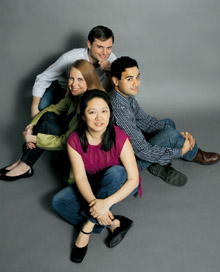
DRAMA In Dohnányi’s Quintet, Rangell played with rhapsodic intensity and ringing clarity, the Daedalus quartet becoming a virtual orchestra. |
Three remarkable pianists who couldn't be more different from one another have made some major appearances in the past few weeks. At the Rockport Chamber Music Festival, Marc-André Hamelin, the Canadian virtuoso, played a varied program beginning with Haydn, Stockhausen, and Ravel and ending with Liszt; then a week later at Rockport, Boston-based pianist Andrew Rangell joined the Daedalus String Quartet. And in town, at Jordan Hall, as part of Stephen Drury's weeklong program in the Summer Institute for Contemporary Performance Practice (SICPP or, more familiarly, Sick Puppy), contemporary-music specialist Ursula Oppens played pieces by three composers born in 1938: John Corigliano, Charles Wuorinen, and Frederic Rzewski.Rockport's glamorous year-old concert hall, the Shalin Liu Performance Center, with its vast picture window at the back of the stage overlooking one of New England's most picturesque harbors, has worn well since it opened last year. Its multi-textured interior — "woven" wooden slats and complex interior stone-work walls — provides a warm, full acoustic for keyboard, as well as for coughers, program rattlers, bleeping hearing aids, and creaking floorboards and seats. That fabulous view can also be distracting, but Hamelin's keyboard wizardry, serious and playful, kaleidoscopicically colored, compelled one's attention.
The first half of the concert had the best music. Haydn's E-minor Sonata, No. 53, echt Haydn, is both commanding and stealthy, jolly and teasing despite almost Mozartean undercurrents of minor-key melancholy. Hamlin delivered this with a glittering crispness that skipped and scampered then stopped abruptly in its tracks. His masterful dynamic range was even more in evidence in Stockhausen's tantalizing Klavierstück IX, which begins with sets of big fortissimo chords and fades to the near silence of almost unheard reverberations. It made a startling but effective modern companion piece to classical Haydn.
Ravel's Gaspard de la nuit has the reputation of being diabolically difficult to play, yet its technical demands are all in the service of creating haunting atmospheres for its three poetic narratives: Ondine (a slippery water-sprite), Legibet (a sinister nocturne depicting an "occupied" gallows), and the breathless, elusively tilted Scarbo (that bone-rattlingly jittery scarab).
The concert ended with two big Liszt extravaganzas, neither a favorite of mine. All the bravura playing in the world (plenty in evidence) couldn't get me interested in the sentimental, sanctimonious pieties of Bénédiction de Dieu dans la solitude or Liszt's bloated "reminiscences" of Norma, which leave out Bellini's best music (Liszt's recollections of Don Giovanni or Rigoletto are far better). Hamelin's encore was his very first public performance of Ravel's most elegant and scintillating water music, Jeux d'eau — surely now a new Hamelin staple.
If Hamelin is especially admired as a performer of the European avant garde (Stockhausen, Boulez), Ursula Oppens is a champion of contemporary American music. I last saw her devote an extraordinary evening at the Boston Conservatory to the complete piano music of Elliott Carter. She made strong cases for Corigliano's Etude Fantasy (1976, revised 2007) and Charles Wuorinen's Oros (written for Oppens in 2009), though each piece left me dissatisfied in opposite ways — the Corigliano intricately structured but musically thin; the Wuorinen so densely improvisational it was impossible to follow any "narrative" thread except that it begins and ends with a similar row of repeated low notes.